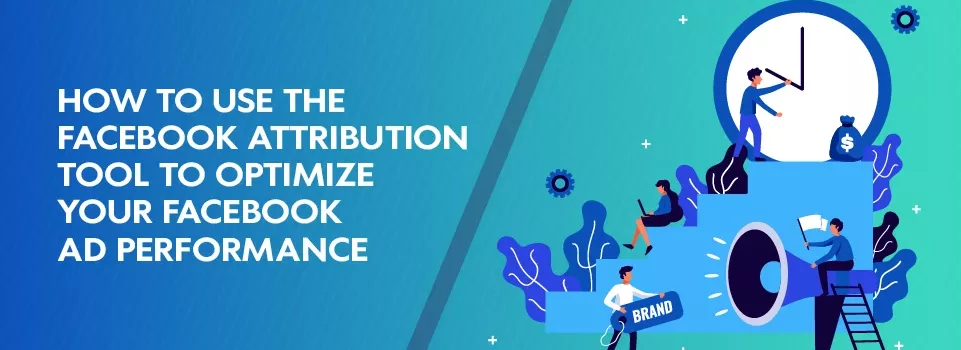What is Facebook Attribution?
Facebook attribution is a tool that helps you track the results generated by your ads according to the rules you set. At first, it may seem difficult to manage but attribution is one of the burning issues for digital marketers.
In general meaning, attribution "attributes" the conversions to certain marketing channels to measure their impact on the outcome of your ad campaigns. Facebook provides priceless data so that you could evaluate the performance of your ads and campaigns.
Let's imagine that someone sees your ad today. It absolutely doesn't guarantee that this person will buy something from you at the exact same moment. It often takes some time and probably browsing other online or offline sources before he or she decides to make a purchase.
Probably your product is too expensive to take an instant action (make an impulse purchase, for example). A person might have accidentally seen your ad and remembered about it a week later, or maybe there was some other reason to make a purchase.
Facebook attribution tool records all these actions.
You can set the Attribution window which is the length of period between when a person first viewed or clicked on your ad and finally converted. Facebook records the customers' actions when they interact with your service (watch your video, add to cart, make a purchase) and helps you keep the statistics on your ads' effectiveness. Facebook will attribute the conversion to the specific ad that led to that conversion if it happened within the predefined period of time.
The Attribution model is a rule that determines the credit given to each touchpoint. Touchpoints are any interactions of people with your brand or company on their way to conversion. Due to the attribution model each touchpoint will get a certain percent of value for the conversion according to the type of attribution model you select.
When you're using multiple channels for advertising, for example, Facebook and Google ads, you don't know for sure which source helped you make a person convert. Fortunately, Facebook is using multi-touch attribution that helps you track all the media channels that got a person to convert. Facebook attribution tool will tell you whether the sale came from Facebook ad, direct traffic, or Google search. At the same time, Facebook's attribution tool lets you track users online cross-devices.
Set up Facebook Attribution in your Business Manager
To start working with Facebook's Attribution tool and track actions happening off Facebook you'll need to set up one of these:
- Facebook pixel. It's a small piece of code that you place on your website to track customers' interactions.
- Mobile SDK, they are used by most software application developers.
- Offline events. You can also add offline event tracking inside your Facebook Ads Manager.
Facebook Attribution models allow you to customize the amount of value attributed to touchpoints for a conversion. Touchpoints are basically the actions taken by the customers, like impressions, clicks, visits to your website on their path to conversion.
In most analytic systems all the value is allocated by default to the last touch interaction. The systems don't take into account previous interactions that might have contributed to the conversion. The benefit of using Facebook's attribution tool is the opportunity to test various attribution models. For example, the credit for the conversion can be given evenly to each action (click or visit), only to the last one or can be positional.
You need to have a Business Manager to be able to set the Attribution model as well as the Attribution window. To start with, you'll need to set up a line of business for your Ad account. Lines of business help you group reports about your Ad accounts, pixels, apps and offline event sets.
Attribution tab is easy to find if you open the dropdown menu and scroll down a little bit to the Analyse and report section.
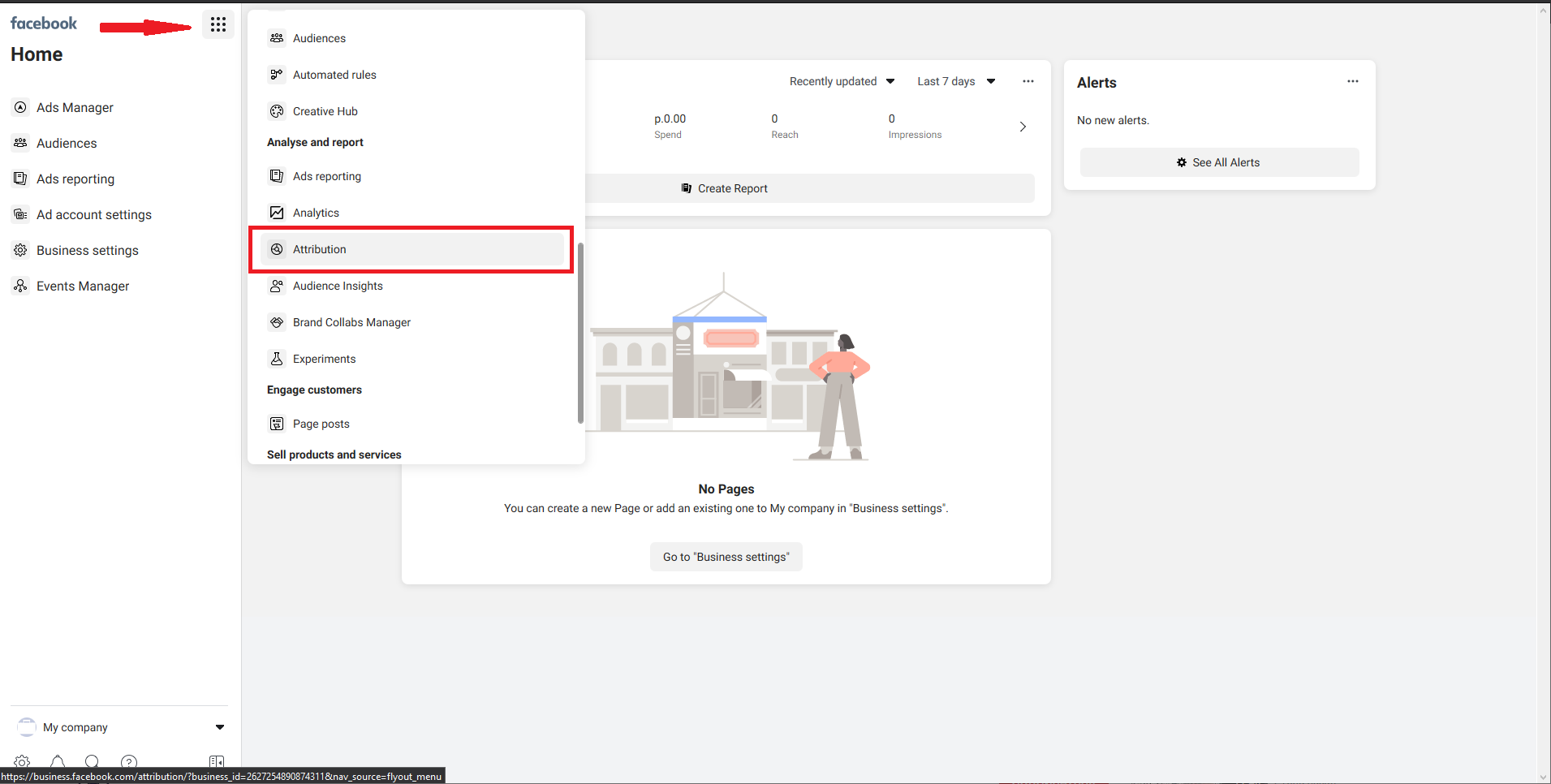
Step 1. First, choose the line of business:
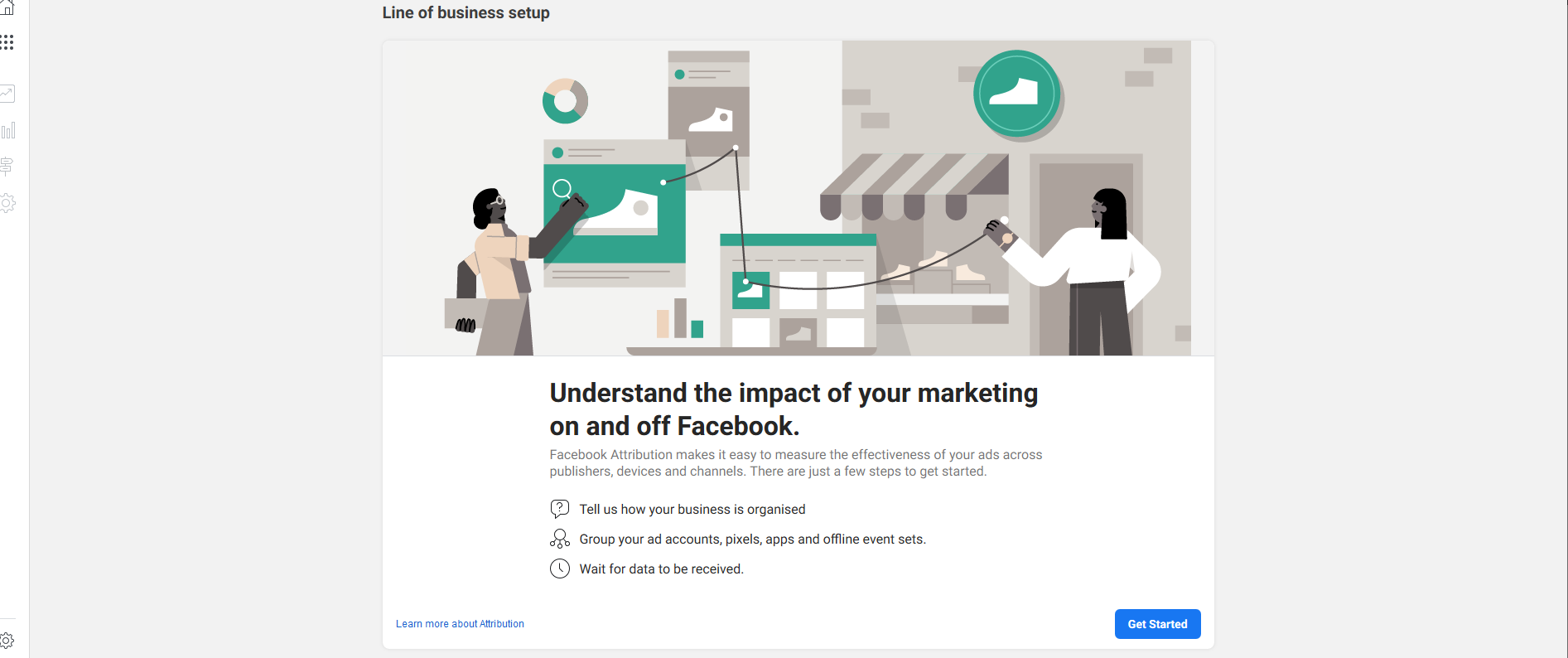
In other words, it's how your business is organized:
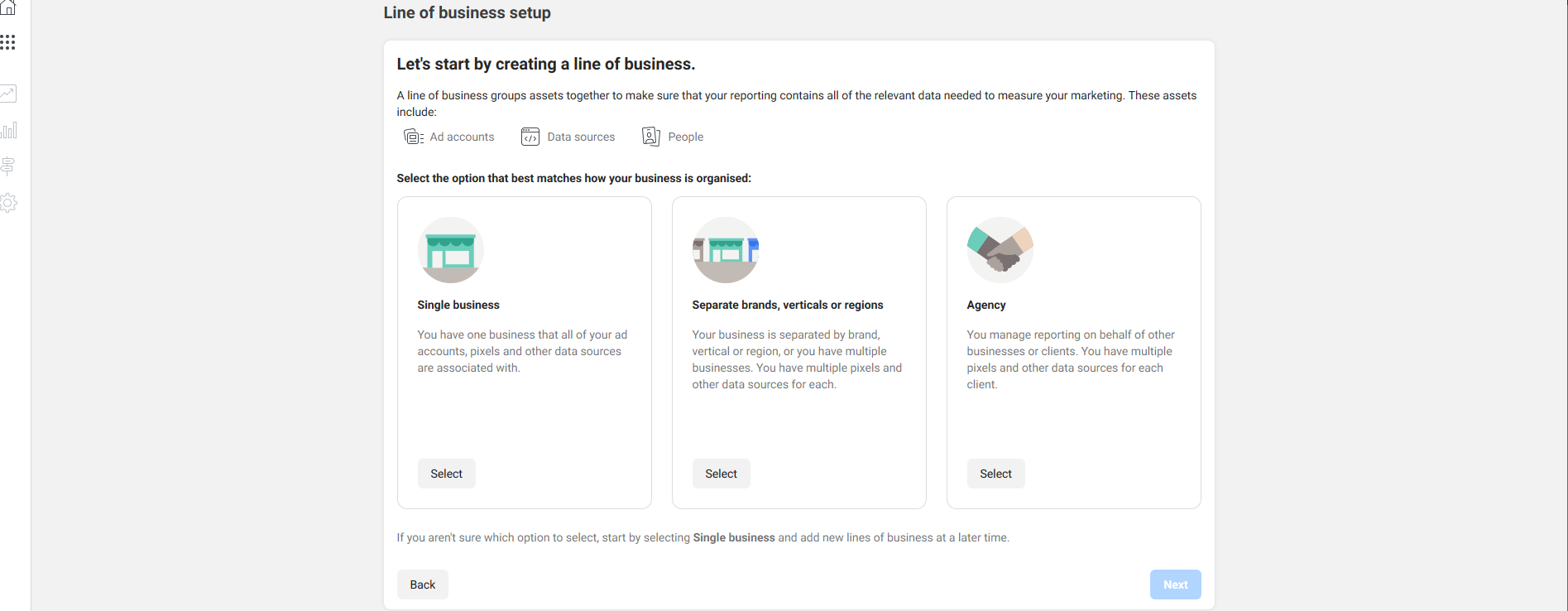
Step 2. Select Ad accounts to be assigned to this line of business.

Step 3. Select data sources: pixels, apps or offline event sets that send the conversion events to Facebook.

Step 4. Select the users that will be able to view the reports for this line of business. This setting can be edited at any time.

Step 5. Choose the zone and currency.

Step 6. Select the name for this line of business.

Step 7. The setup process is almost over. You have to wait for a couple of hours for your line of business to receive the data from your ads.
Now you need to wait for a while. Facebook needs some time to pull up the data.

Data will be catching up within a few hours or more.
After receiving all the data you can set up the attribution settings.
First, you need to select the conversion event you want to analyze in the upper right corner.

Next to the event conversion is the time range of the reporting period. The Attribution tool doesn't take into account previous data. It will start accumulating data from the day of the setup.

Then you can choose the Attribution model for analysis.
Select the Attribution Model
By default Facebook uses last-click attribution meaning the conversion is attributed to the last taken action, but if you want to change the attribution model for your Ad account, Facebook provides 9 types of Attribution models.
To better understand each model, let's take an example when a person makes a $60 purchase on your website. Before that purchase, they first saw your ad on Instagram, then found your Facebook page and signed up for your newsletter. Finally, that person googled your website to make a purchase. There are 4 touchpoints between your customer and your business. Here are the types of models and a little description of each type.
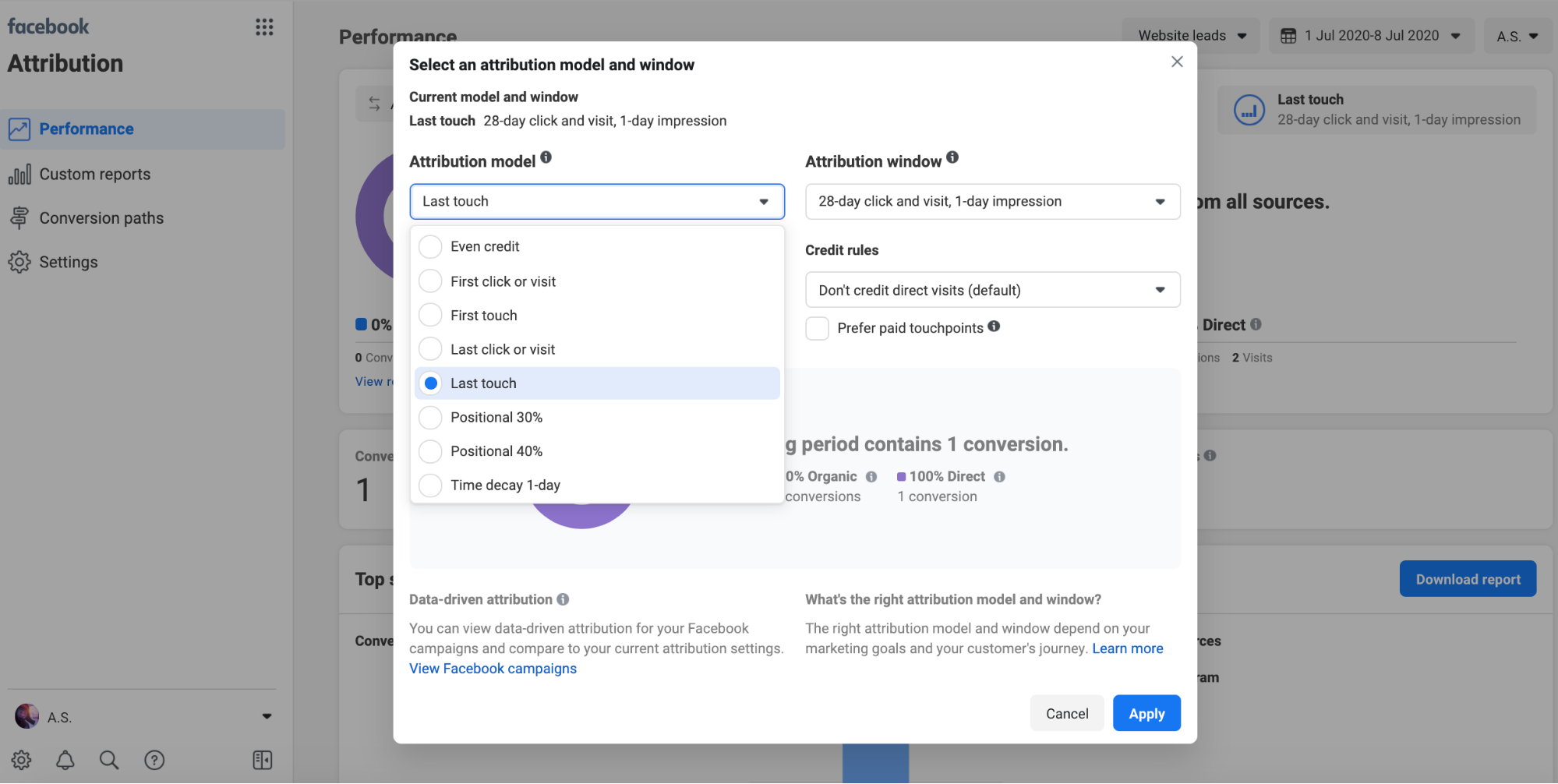
- Even credit
This model distributes the even amount of value to all the touchpoints on the path to conversion, so that in our case each touchpoint will get 25% or $15 conversion value.
- First click or visit
The first click or visit gets 100% of the credit for the conversion. $60 of conversion value is attributed to the first click or visit.
- First touch
In contrast to the previous option, in this one the views are also counted. In case of the absence of clicks and visits, 100% of the credit for the conversion is attributed to the first view.
- Last click or visit
Like in the case with the first click or visit, all the credit is attributed to the last click or visit.
- Last touch
Similarly to the first touch model, last touch (whether it’s a view, click or visit) gets 100% credit.
- Positional 30% and Positional 40%
The first and the last actions get a certain amount of value of conversion each, the rest is distributed equally among other touchpoints. There are two variations: 30% or 40%.
For example, with the Positional 30% model, the first and the last touchpoint will be attributed $18 of conversion value, the other two touchpoints in the middle - $12 each.
- Time Decay 1-Day and Time Decay 7-Day
Facebook attributes value to touchpoints as they get closer to the conversion and gives more credit to the most recent touchpoints. The first click gets the least and the last click gets the most value. Here are also two different variations: 1-day and 7-day.
Select the Attribution Window
The Attribution window defines what touchpoints and for what period of time will be counted by the Attribution model.
There's a limited choice of Attribution windows in the Ads Manager. It's restricted to 1-day, 7-day and 28-day windows. Attribution tool offers much broader choice including 14-days, 30-days and 90-days windows.

Then you just click on Apply and wait for the information to catch up. The results in the Performance tab will look like this.

The choice of the attribution model will depend on the product you're promoting. The more expensive and substantial your product is, the longer the Attribution window and the more touchpoints it requires.
Analyze the effectiveness of your ad campaigns
After you have chosen the Attribution window and the Attribution model, you're good to go: proceed with tracking the effectiveness of your ads.
Facebook Attribution tool represents an invaluable instrument in the right hands. Whatever services you're using for running ads, setting up an ad is just a half of work. In the long run, the success of your ad campaign will depend on your ability to analyze and interpret the marketing results provided by Facebook.
The most important thing you should remember about choosing attribution windows is that the longer the attribution window you set the higher the possibility that Facebook will take credit for 100% of conversions that might have been generated by other sources. The results for 1-day click will be much more precise than if you set 28-day click-through attribution. The high results for the 28-day window might be confusing and bring the marketers to the wrong conclusions.
In case Facebook ads is your only marketing channel, you can stick to the default attribution window. If you're also advertising on other platforms, you should consider setting a more narrow attribution window for analyzing your ad campaign results.
Fortunately, due to the integration with Google, the Facebook Attribution Model tool allows you to pull up the results from Google Ads.
Anyway, the results of different attribution windows will allow you to define your products’ sales cycle. It will provide insight into the performance of your ad campaigns and detect their weaknesses.
Test different models for analysis purposes. There’s no perfect one because basically the Facebook attribution is based on the assumptions. You can't control human minds to know for sure what forced them to convert and weigh each point of interaction with your business. Later you just stick to the one which best fits your business.
